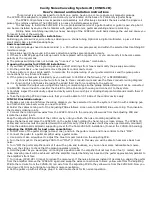
Cavity Noise Canceling System-JR (CVNCS-JR)
User's manual and installation instructions
This product is mainly designed for retrofit on a guitar, having one or more single coil magnetic pickups.
The CVNCS-JR is adapted to replace the control cavity cover located on the back of LP Junior style guitar body.
The CVNCS-JR contains a low impedance coil assembly so it effectively eliminates the noise while the single coil
pickup tone retains unaltered. The CVNCS-JR is an easy to install passive system.
The best way to install the CVNCS-JR is to use professional service of a guitar builder or guitar repair shop but it
can be also installed by anyone that is familiar with guitar electronics, guitar assembling and wire soldering.
Drilling holes, scratching insulation or heavy bending of the CVNCS-JR could badly damage the unit and cause you
to lose all terms of the warranty.
Tools and materials needed for installation:
Soldering gun, screw driver, wire cutters, soldering wire, shrink tubing. Optional: a digital multimeter, a piece of foam,
small plastic bag, electrical/masking tape.
Basic requirements:
1. All single coil pickups need to be same kind (i. e. P90 with screw pole pieces) and within the selected best matching DC
resistance range
2. All pickups need to be wound in the same direction and the same magnetic polarity.
3. If there is a RWRP pickup this pickup needs to be replaced with a regular one, or you can modify it to become same
polarity as the regular one
4. The pickups switching does not include any "in series" or "out of phase" combination.
Preparing the guitar for CVNCS-JR installation:
1. If you need to modify the single coil pickups - pull off all strings from tuners and modify the pickups accurately.
2. On the guitar back - unscrew and remove the plastic control cavity cover.
3. Take a picture or do a simple sketch to memorize the original wiring of your guitar electronics and the pickup wires
connections for any future references.
4. If the pickup output wire is braided type you will need to do ONE of the following ("a" is RECOMENDED):
a) Convert the pickup output wire from two to three conductor wire and use the three conductor wiring diagram
as it is shown on this print back side (using the added third line for connecting to the system)
b) Isolate the output wire using shrink tubing or isolation type so the pickup braided shield will not be connected
to GROUND. You will need to unsolder the shield from the Volume pot housing and connect it to the system.
5. Carefully inspect the side cavity edges and cavity walls for wood chips or sticking sharp materials and smooth them if
necessary.
6. Take the Adjusting PCB and make sure that you will be able to fit it inside of the control cavity easily.
CVNCS-JR installation steps:
A. Prepare your pickup and follow the wiring diagram you have selected to wire the system. Fresh tin with soldering gun
and fresh solder wire every wires you need to solder
B. Solder the cables coming out of the Adjusting PCB as follows: Green wire to GROUND; Blue wire to Bg. Then insolate
the created soldering joints.
C. Connect the red and yellow wires from the CVNCS-JR coil to the red and yellow wires from the adjusting PCB and
isolate the created joints.
Keep the adjusting PCB outside of the control cavity until you finish the noise canceling adjustments.
Shape the harness and place the CVNCS-JR on the guitar back holding it by hand, type or loose screws. The CVNCS-JR
yellow and red wires must be pointed toward the control cavity (this is the way it will stay when permanently mounted)
D. Use the additional small plastic supporting cover for the final CVNCS-JR installation (to avoid the CVNCS-JR bending).
Adjusting the CVNCS-JR for best noise cancellation:
1. Put ON some of the guitar strings (at least one), and turn the guitar volume and tone controls to their “MAX”.
2. Connect the guitar to a guitar amplifier using a guitar cable.
3. Use a correct size screwdriver to adjust the blue trim pots located on the adjusting PCB.
4. Turn the trim pot on the adjusting PCB to their “MAX” (100%). In this way you will be able to hear some basic hum
noise.
5. Turn “ON” the guitar amplifier and set it up with a gain and loudness, so you can hear some noticeable hum noise.
Play over the strings to check that the pickup operates normally
6. Hold the guitar as you would play on it and get a position near the amplifier but not less than 3 feet (1 meter). Best
noise canceling result will be achieved with the amplifier located behind your back and the guitar approximately parallel to
the amplifier's front face.
7. Turn down (CCW) VR1 trim pot to reduce the noise level. If the noise increases instead of decreasing, unplug the guitar
from the amplifier remove the CVNCS-JR again and swap the wires connection as follows: yellow wire from the adjusting
PCB to the red wire from the CVNCS-JR; red wire from the adjusting PCB to the yellow wire from the CVNCS-JR. Now you
turn down VR1 trim pot until get an optimum noise cancellation.
8. Set the guitar up with all strings, plug it in and double check for its normal operation.




















